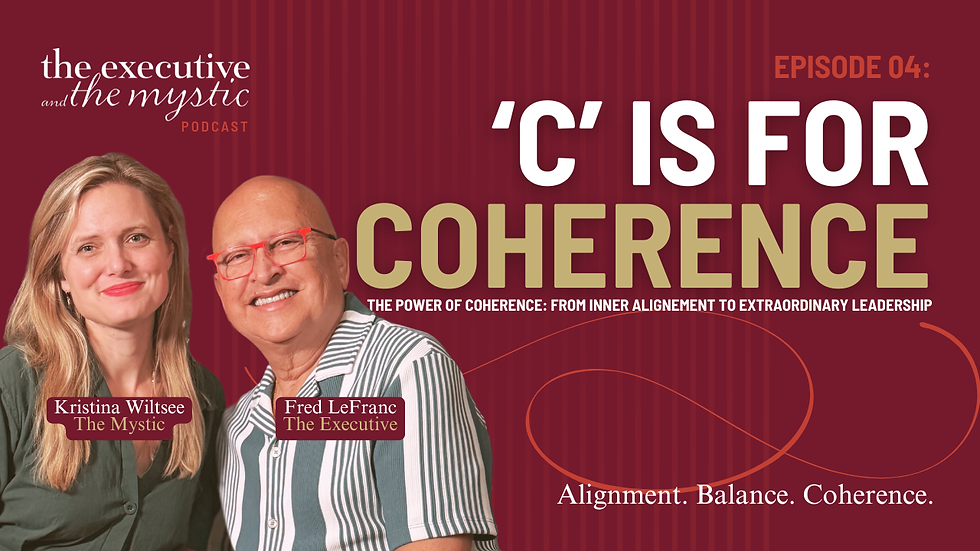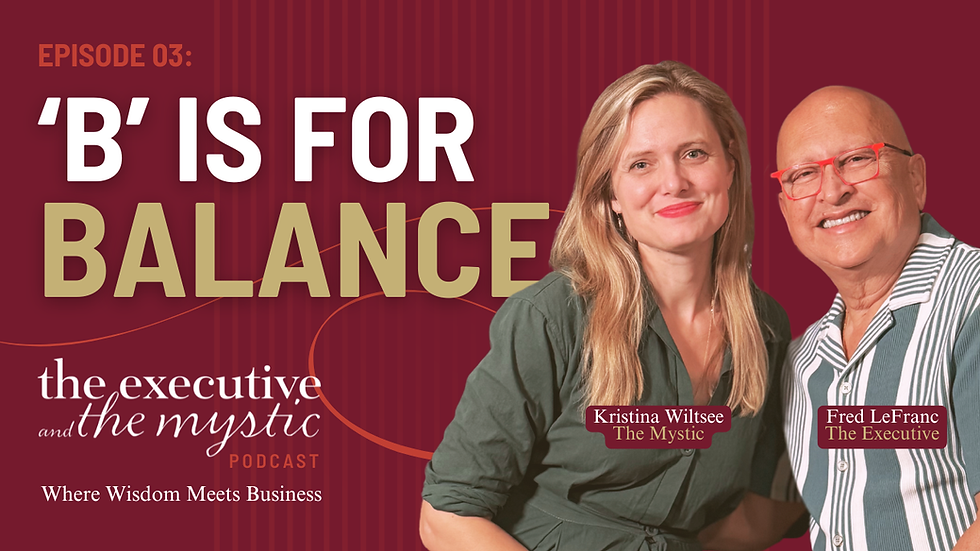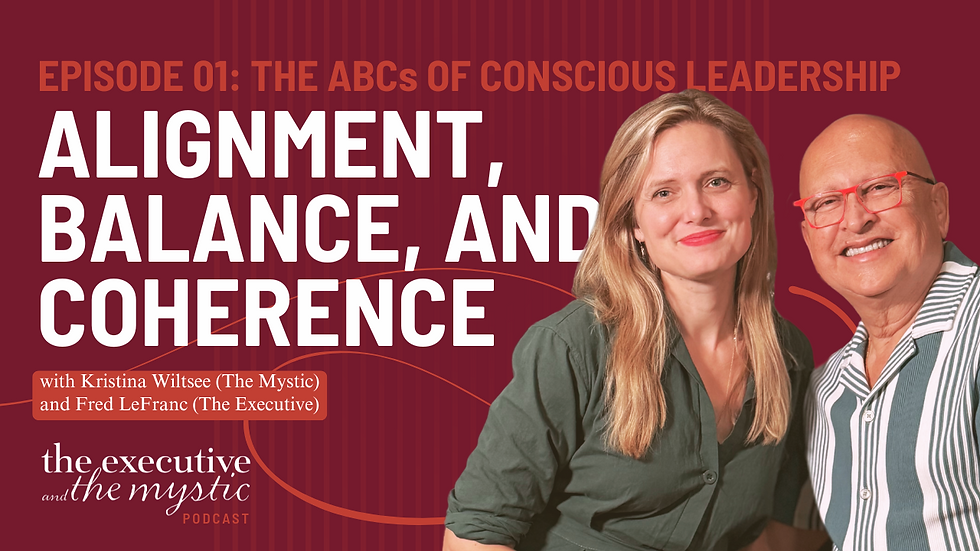Episode 2: A is for Alignment
- Kristina Wiltsee
- Apr 22
- 4 min read
Updated: Nov 9
The Power of Alignment: How Leaders Rise Above Circumstance
By Kristina Wiltsee & Fred LeFranc | The Executive and the Mystic
“You have to get the right altitude to have the right attitude.” – Kristina Wiltsee
In our latest conversation on The Executive and the Mystic, we explored the “A” in our ABCs of leadership: Alignment. It’s the foundation for every transformational leader—and it’s as personal as it is organizational.
Let’s break it down.
Alignment Begins with the Individual
As leaders, we all face moments when the world tests our convictions. Even if we align ourselves with conscious capitalism or principle-based leadership, reality can hit hard. The question becomes: Can we rise above it?
We believe alignment starts with perspective. Many people live their lives stuck in a personal story—a narrative shaped by old pain, drama, or limiting beliefs. These stories often trap us in roles from the Drama Triangle: victim, persecutor, or rescuer. And when we’re in that mindset, we feel small—isolated, reactive, and powerless.
But when we tap into a bigger story, something shifts.
Think of it like flying a plane. When you’re grounded, your view is limited. But once you ascend, the landscape changes. You gain freedom of movement and choice. That altitude represents the bigger self—a self that isn’t ruled by fear or old narratives, but by vision, purpose, and love.
The Universe is Neutral (And That’s a Good Thing)
One of the universal principles we explore in our work is this: The universe is neutral.
This doesn’t mean life is cold or uncaring. Quite the opposite. It means that life doesn’t punish or reward us—it simply responds. What we bring to it, we receive. It’s our mind that labels things good or bad. And when we pause that judgment, we step out of victimhood and into agency.
As Fred says, “Pain is inevitable. Suffering is optional.” When we let go of catastrophizing, we align with a more spacious reality—one that gives us choice, movement, and resilience.
From Limiting Beliefs to Limitless Possibilities
Limiting beliefs often masquerade as strategies: “If I stay quiet, I won’t be hurt.” “If I do it all myself, I won’t be let down.” These seem like protective mechanisms, but they keep us stuck.
Alignment is the process of recognizing these beliefs for what they are—and choosing something bigger. And yes, that choice can be instantaneous. You don’t need 30 days to decide to run a marathon. The decision can happen now. The practice and the coherence come after.
As Kristina puts it, “Alignment is choosing a more loving, integrated, and limitless form of seeing yourself.”
What Happens When Leaders Align
When leaders do this inner work, something incredible happens: their organizations reflect it.
Your mindset becomes culture. If you feel stuck, your team will too. If you’re aligned with a greater purpose and open to shared vision, your team will rise with you.
Fred shares a moving story from his time leading a bakery through the challenges of COVID. Instead of top-down directives, he listened. He improved working conditions. He showed up with humanity. And one day, a woman in the breakroom said, “God sent you to help us—and because of that, we’re going to help you.”
That’s the power of alignment in action.
Shared Vision: The Heart of Organizational Alignment
After personal alignment comes shared vision. Vision isn’t just numbers on a spreadsheet—it’s a movie in the mind, an emotional truth that pulls people forward. When everyone sees the same horizon, when they feel part of something bigger than themselves, that’s when magic happens.
Fred calls this disagree and commit. You don’t need full consensus. But you do need trust. People can say, “I don’t fully see it yet, but I believe in us—and I’m all in.”
That’s culture. That’s momentum.
Three Core Principles of Alignment
We closed with a few guiding principles that underpin this kind of leadership:
1. The Universe is Neutral
Let go of judgment. Step into perspective. Choose your response.
2. As Above, So Below (Law of Correspondence)
The alignment of one affects the whole. The internal work shows up externally.
3. Shared Vision is Everything
Invite people into the bigger story. Celebrate small wins. Let the vision be emotional, not just strategic.
Kindness Over Niceness
Finally, we touched on the importance of leading with kindness—not niceness. Niceness seeks approval. Kindness upholds dignity while holding firm boundaries. Kindness says: I care about you enough to be honest. I believe in your potential, not just your comfort.
Watch Episode 2 here:
Coming Up Next: Balance
We’re just getting started with the ABCs. Next time, we’ll dive into Balance—how leaders stay centered amidst chaos, and how organizations hold multiple perspectives without collapsing.
If anything in this dialogue sparked your interest, we’d love to hear from you. Send your thoughts or questions to growth@theexecutiveandthemystic.com and we might feature them in a future episode.
Until then, may you find the altitude that gives you perspective—and the alignment that fuels your leadership.




Comments